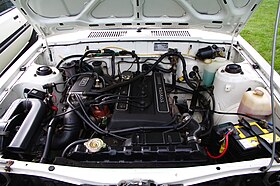| T engine | |
|---|---|
 2T-GEU engine in a Toyota Sprinter | |
| Overview | |
| Manufacturer | Toyota |
| Production | 1970–1985 |
| Layout | |
| Configuration | Straight-4 |
| Displacement | 1,407–2,090 cc |
| Cylinder block material | Cast iron |
| Cylinder head material | Alloy |
| Combustion | |
| Fuel type | Petrol |
| Cooling system | Water-cooled |
| Output | |
| Power output | 64–441 kW (86–592 hp; 87–600 PS) |
| Torque output | 105–206 N⋅m (77–152 lb⋅ft) |
The Toyota T series is a family of inline-4 automobile engines manufactured by Toyota beginning in 1970 and ending in 1985. It started as a pushrod overhead valve (OHV) design and later performance oriented twin cam (DOHC) variants were added to the lineup. Toyota had built its solid reputation on the reliability of these engines.
The 4T-GTE variant of this engine allowed Toyota to compete in the World Rally Championship in the early 1980s, making it the first Japanese manufacturer to do so.
Race engines based on the 2T-G include the 100E and 151E.
- All T engines utilize a timing chain and have a cast iron block with an alloy cylinder head with hardened valve seats and a hemispherical combustion chamber design (HEMI).
- All T engines are carburetted except those with electronic fuel injection, "E" designation.
- All T engines use a 2 valve OHV design except those with a DOHC performance head, "G" designation.
- The 12T/13T has a sub-cylinder directly behind the spark plug that leads into a smaller chamber for emission purposes.